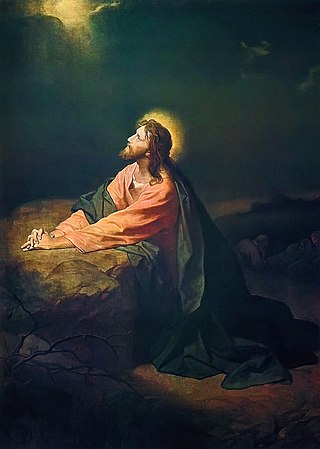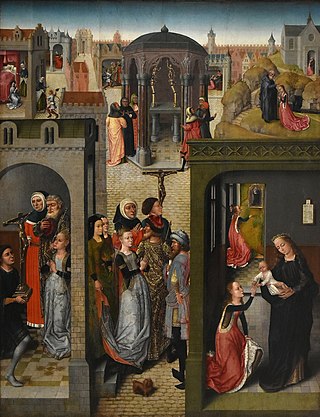
The Last Supper is a mural painting by the Italian High Renaissance artist Leonardo da Vinci, dated to c. 1495–1498. The painting represents the scene of the Last Supper of Jesus with the Twelve Apostles, as it is told in the Gospel of John – specifically the moment after Jesus announces that one of his apostles will betray him. Its handling of space, mastery of perspective, treatment of motion and complex display of human emotion has made it one of the Western world's most recognizable paintings and among Leonardo's most celebrated works. Some commentators consider it pivotal in inaugurating the transition into what is now termed the High Renaissance.

Pietro Lorenzetti or Pietro Laurati was an Italian painter, active between c. 1306 and 1345. Together with his younger brother Ambrogio, he introduced naturalism into Sienese art. In their artistry and experiments with three-dimensional and spatial arrangements, the brothers foreshadowed the art of the Renaissance.

Simon Vouet was a French painter who studied and rose to prominence in Italy before being summoned by Louis XIII to serve as Premier peintre du Roi in France. He and his studio of artists created religious and mythological paintings, portraits, frescoes, tapestries, and massive decorative schemes for the king and for wealthy patrons, including Richelieu. During this time, "Vouet was indisputably the leading artist in Paris," and was immensely influential in introducing the Italian Baroque style of painting to France. He was also according to Pierre Rosenberg, "without doubt one of the outstanding seventeenth-century draughtsmen, equal to Annibale Carracci and Lanfranco."

The agony in the Garden of Gethsemane is an episode in the life of Jesus, which occurred after the Last Supper and before his betrayal and arrest, all part of the Passion of Jesus leading to his crucifixion and death. This episode is described in the three Synoptic Gospels in the New Testament. According to these accounts, Jesus, accompanied by Peter, John and James, enters the garden of Gethsemane on the Mount of Olives where he experiences great anguish and prays to be delivered from his impending suffering, while also accepting God's will.

Ventura di Archangelo Salimbeni was an Italian Counter-Maniera painter and printmaker highly influenced by the vaghezza and sensual reform of Federico Barocci.

The Isenheim Altarpiece is an altarpiece sculpted and painted by, respectively, the Germans Nikolaus of Haguenau and Matthias Grünewald in 1512–1516. It is on display at the Unterlinden Museum at Colmar, Alsace, in France. It is Grünewald's largest work and is regarded as his masterpiece. It was painted for the Monastery of St. Anthony in Issenheim near Colmar, which specialized in hospital work. The Antonine monks of the monastery were noted for their care of plague sufferers as well as for their treatment of skin diseases, such as ergotism. The image of the crucified Christ is pitted with plague-type sores, showing patients that Jesus understood and shared their afflictions. The veracity of the work's depictions of medical conditions was unusual in the history of European art.

Lorenzo de Caro was an Italian painter, active in the late Baroque style in his native city of Naples.

The Maestà, or Maestà of Duccio, is an altarpiece composed of many individual paintings commissioned by the city of Siena in 1308 from the artist Duccio di Buoninsegna and is his most famous work. The front panels make up a large enthroned Madonna and Child with saints and angels, and a predella of the Childhood of Christ with prophets. The reverse has the rest of a combined cycle of the Life of the Virgin and the Life of Christ in a total of forty-three small scenes; several panels are now dispersed or lost. The base of the panel has an inscription that reads : "Holy Mother of God, be thou the cause of peace for Siena and life to Duccio because he painted thee thus." Though it took a generation for its effect to be truly felt, Duccio's Maestà set Italian painting on a course leading away from the hieratic representations of Byzantine art towards more direct presentations of reality.

The Crucifixion with the Virgin and St John by Hendrick ter Brugghen is an oil painting, now in the Metropolitan Museum of Art in New York City. It was probably painted c. 1625 as an altarpiece for a Catholic schuilkerk, a "hidden church" or "church in the attic", in the Calvinist Dutch United Provinces, probably Utrecht. When discovered in a bombed out church in South Hackney, London in 1956, it was unknown, but by the time it appeared in Sotheby's salesroom in November of that year it was recognized as an important example of Utrecht Caravaggism. It was acquired by the museum in the sale.

The life of Christ as a narrative cycle in Christian art comprises a number of different subjects showing events from the life of Jesus on Earth. They are distinguished from the many other subjects in art showing the eternal life of Christ, such as Christ in Majesty, and also many types of portrait or devotional subjects without a narrative element.

The Museum of Fine Arts of Lyon is a municipal museum of fine arts in the French city of Lyon. Located near the Place des Terreaux, it is housed in a former Benedictine convent which was active during the 17th and 18th centuries. It was restored between 1988, and 1998, remaining open to visitors throughout this time despite the ongoing restoration works. Its collections range from ancient Egyptian antiquities to the Modern art period, making the museum one of the most important in Europe. It also hosts important exhibitions of art, for example the exhibitions of works by Georges Braque and Henri Laurens in the second half of 2005, and another on the work of Théodore Géricault from April to July 2006. It is one of the largest art museums in France.

Louis Cretey, formerly known as Pierre-Louis Cretey, was a French baroque painter and one of the leading masters in the Lyonnaise school.

Crucifixions and crucifixes have appeared in the arts and popular culture from before the era of the pagan Roman Empire. The crucifixion of Jesus has been depicted in a wide range of religious art since the 4th century CE, much of which has included the appearance of mournful onlookers, the Virgin Mary, angels, Pontius Pilate and even antisemeitc depictions of deicidal Jews. In more modern times, crucifixion has appeared in film and television as well as in fine art, and depictions of other historical crucifixions have appeared as well as the crucifixion of Christ. Modern art and culture have also seen the rise of images of crucifixion being used to make statements unconnected with Christian iconography, or even just used for shock value.

Schelte a Bolswert (1586–1659) was a leading Dutch engraver, noted for his works after Rubens and Van Dyck.

The Master of the Legend of Saint Catherine is the notname for an unknown late 15th century Early Netherlandish painter. He was named after a painting with Scenes from the Legend of Saint Catherine, now kept in the Royal Museums of Fine Arts of Belgium. He was active between c. 1470 and c. 1500, probably around Brussels.

The Rockox Triptych or Epitaph of Nicolaas Rockox and His Wife Adriana Perez is a triptych painted by the Flemish painter Peter Paul Rubens between 1613 and 1615. It is in the collection of the Royal Museum of Fine Arts Antwerp.

The Annunciation is an oil painting by the Early Netherlandish painter Hans Memling. It depicts the Annunciation, the archangel Gabriel's announcement to the Virgin Mary that she would conceive and become the mother of Jesus, described in the Gospel of Luke. The painting was executed in the 1480s and was transferred to canvas from its original oak panel sometime after 1928; it is today held in the Robert Lehman collection of the Metropolitan Museum of Art in New York.

The Orsini Altarpiece, Orsini Polyptych or Passion Polyptych is a painting produced at an unknown location by Simone Martini for private devotion by a cardinal of the Orsini family. Its precise date is still under discussion. It was taken to France very early in its lifespan and formed a major influence on late medieval French artists. It is now split between the Louvre, the Royal Museum of Fine Arts, Antwerp and the Gemäldegalerie.

Small Passion is a series of 36 woodcuts and a frontispiece by Albrecht Dürer. One of the best surviving sets is now in the British Museum in London. It was produced in 1511 as a new set of works on Biblical themes and the life and Passion of Christ in 1511, the same year as he republished earlier works such as Apocalypse.



















